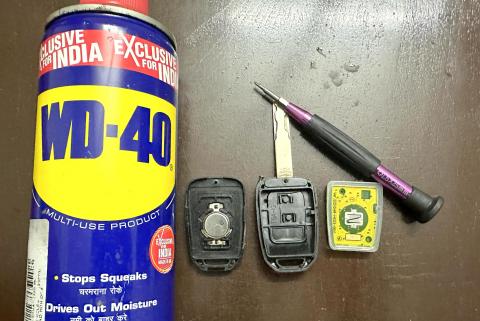I went to the service centre where the service advisor blindly said that the key had to be replaced and that would cost around Rs 5,000.
BHPian ezhil0707 recently shared this with other enthusiasts.
I own a 2016 Honda City iVTEC V MT. I am super happy with the ownership experience so far. I never faced a technical issue in 7 years until the day I found my keys to keep the red light frozen and didn’t lock/unlock the doors.
I assumed it’s the battery which has aged 7 years since the date of purchase. I visited the nearest A.S.S in Coimbatore and as expected the SA blindly said that my key had to be replaced which is around 5k or I had the option to use my spare key.
I decided to fix this issue myself experimenting by going through a lot of forums and YT videos.
Things I purchased include a set of precision screwdrivers (you need a +1.5x25mm size for most of the keys) with a pry tool (FYI: the SA opened my keys with a screwdriver and a coin and damaged the plastic and the alignment. I wonder how A.S.S doesn’t equip them with these minor tools).
I strongly recommend using a prying tool to save your key’s plastic alignment. I opened my key fob and I wanted to try my first luck which is WD-40 spray which will help in cleaning the contacts on the board, if at all present which was posted in many of the videos/forums.
So I tried to take out the board and sprayed a very minimum quantity, cleaned the surface and allowed it to dry for a day. I reassembled it and to my surprise, I got my key back in action.
I am really not sure of what fixed this, but sharing the experience of how investing in a set of tools which cost me roughly Rs 400 Rs for a set of precision screwdrivers and a pry tool can save you with a blind key replacement of 5k.
Is there anybody who has faced this issue and can someone educate us on this with exact data pointers?
Thanks in Advance.
Here’s what BHPian Jeroen had to say about the matter:
There are a couple of things that can fail on a FOB and do so.
Obviously, the first one is the battery, it runs out and just requires replacing. Make sure the battery fits snugly onto the two contacts. One underneath, one on the side.
The second problem can be the failure of the microswitches. Sometimes just dirt and then a good cleaning with a good electro cleaner might do the trick.
Sometimes the microswitches are actually broken. They can be replaced, but you need to find a good replacement.
It is very rare for the actual electronic components to go bad. I have seen one case where some of the soldering was done poorly and came undone.
When cleaning the electrical bits off, it is best to use a proper electro cleaner. WD40 is fine as is not conductive, but it will leave some sticky residue behind.
Whereas fixing a FOB tends to be relatively easy, reprogramming it might not. The more fancy the car, the more complex the reprogramming procedure will be, sometimes requiring special equipment.
Check your owner’s manual. Replacing the FOB battery should be described, including on how to open the FOB. It will also state if any reprogramming needs to be done.
Here you see me fixing my Jeep’s FOB very similar to how you did yours.
Here’s what BHPian KHegde had to say about the matter:
As Jeroen has pointed out, one of the reasons for a FOB Key not functioning could be the requirement of a battery replacement. You would need to refer to your car’s owner’s manual for detailed instructions.
I can vouch for the above from personal experience. I have replaced the key FOB batteries twice on our 2013 Global Ford Fiesta which came with only 1 key FOB and 1 regular key and once on our 2019 Maruti Suzuki Ertiga for both key FOBs.
Here’s what BHPian arnieshwartz had to say about the matter:
We encountered the exact same problem with the key fob for the 2017 Honda WRV (has the same key as in the original post).
Opened it up, cleaned the circuit board generously using rubbing alcohol and Q-tips and even changed the battery for good measure. Put it all back together and it started working okay again.
I’m not sure what caused it to stop working in the first place. The original battery wasn’t exactly weak when checked using a multi-meter so it must’ve been something else that thankfully went away.
I even saw a YouTube video that involved shorting some IC pins but without any mention of exactly which pins. Needless to say, I did not have to try that method.
Check out BHPian comments for more insights and information.
Source: Read Full Article

